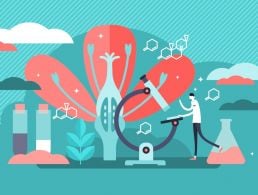Johnson & Johnson’s Ger Madden discusses the important role tech plays in the healthcare sector and the challenges that can arise.
While life sciences companies have many career opportunities in the pharma, biotech and manufacturing spaces, there is also a strong need for technologists.
Ger Madden is the senior director for Johnson & Johnson’s technology services. Originally from Limerick, Madden studied public administration and did his undergraduate degree at University of Limerick (UL). However, it was a co-op placement with Limerick County Council that first sparked his interest in IT.
“From there, I went on to do a graduate diploma in computing and was lucky enough to get a scholarship from UL to complete my master’s in computer science.”
Now, Madden is responsible for the software development team at Johnson & Johnson’s Limerick site, as well as the team that supports manufacturing, distribution and R&D in EMEA.
“Our EMEA-based teams support the infrastructure and applications that enable our manufacturing sites and distribution centres to complete their business processes. This includes Johnson & Johnson’s largest contact lens manufacturing site, which is in Limerick, our orthopaedics plant, DePuy Ireland in Cork, and our biological manufacturing sites in Cork and Leiden in the Netherlands.”
The development team in Limerick works on a wide range of products, from Nicorette’s smoking cessation app to data analytics and business intelligence tools for the company’s manufacturing plants.
Madden said the team also develops the laboratory information management system for the pharmaceutical group of companies to ensure products are released correctly.
‘One ongoing challenge has been making technologists aware of just how essential software is to the healthcare sector’
– GER MADDEN
What brought you from the tech sector to healthcare?
Earlier in my career, I worked in a number of start-ups and technology was absolutely key to the building and selling of the products we made. Given this background, I’ve always seen myself as a businessperson first and an IT one second, but I’ve always had a huge interest in how tech can improve people’s lives and a company’s ways of working. It’s also a helpful lens to apply to understand both the challenges and the opportunities within a business.
As to how I ended up in healthcare, an opportunity came about a few years ago to join Johnson & Johnson Vision Care in Limerick. I had never worked in life sciences before, but knew I could probably apply my principles on how tech can be an enabler for good to this role.
My experience since, working across all of Johnson & Johnson’s businesses, has taught me that IT is an absolute essential component in advancing the solutions and products in our medtech and pharmaceutical businesses, and the products we make for our customers and patients.
What are some of the biggest challenges around building a software team in a healthcare company?
I’ve been lucky enough to oversee the development of a highly successful and hugely capable team here in Limerick over the past number of years, but that’s not to say that it hasn’t come without its challenges!
One ongoing challenge has been making technologists aware of just how essential software is to the healthcare sector and showing how they can have tech career in healthcare, as opposed to only looking at the tech sector itself.
As a company, we are working at doing a better job of informing technologists about what Johnson & Johnson does – how our software team in Limerick and other sites plays a vital role in delivering solutions that are advancing our Johnson & Johnson medtech and pharmaceutical businesses.
Like everyone else, we’re operating in a very competitive market for talent. The tech skills and experience we need are in high demand and it has absolutely been a challenge to find the people we need to grow our team. We are currently actively recruiting for lead software developers, lead data engineers, Salesforce developers and more. The opportunities in our business are endless and it’s an exciting time for us.
Likewise, we’re also figuring out how to navigate the post-Covid hybrid working model. The balance of working from home and the connection in the office is important to us and one of our top priorities. At Johnson & Johnson, we’ve introduced a hybrid model that allows team members more time at home, while also looking to ensure teams spend time at the office to maintain and deepen connections with their teammates and the company.
I have an open-door policy in the office and I hope my team always feel they can come to me with any issues they need resolved or just a chat about how life is going for them. It’s so important to connect with your team and it’s that connection that makes us strive to do better and to reach our potential.
How have you seen diversity and inclusion change in your time in the STEM industry?
I’ve seen huge changes to the STEM demographic during my time in the industry, which is absolutely to be lauded and welcomed, but a lot more needs to be done. Diversity, equity and inclusion is something we place a big emphasis on at Johnson & Johnson, but it needs to be front and centre for every company as something they actively engage in and promote, not just pay lip service to.
From a personal perspective, the value of diversity is something I was aware of from my early childhood, although we might not necessarily have used that word for it! My dad passed away when I was very young and I grew up very close to my mother, sisters and grandmother – being surrounded by such strong women meant I saw them as equals and role models.
I think we need to teach people from a very early age about the importance of treating everyone as equals in terms of awareness, education and training. For the STEM industry, this also means partnering with schools and colleges to promote equal opportunity for everyone in the topics of STEM and associated careers.
In terms of gender equality, Johnson & Johnson has some fantastic learning programmes which teach us how to really examine how we learn gendered behaviours and expectations from early childhood and how to break down those internalised lessons in order to confront our own stereotypes. As a father of sons, those kinds of learnings are invaluable to me.
Of course, diversity and inclusion is about more than just gender, and companies – including Johnson & Johnson – need to really look hard at how they’re engaging with communities across the spectrum of ethnicity, ability, identification, education, the works. Representation really does matter.
10 things you need to know direct to your inbox every weekday. Sign up for the Daily Brief, Silicon Republic’s digest of essential sci-tech news.




